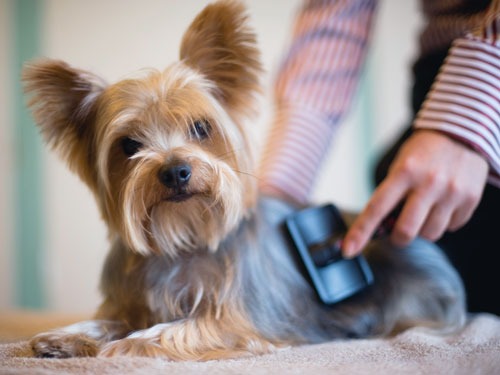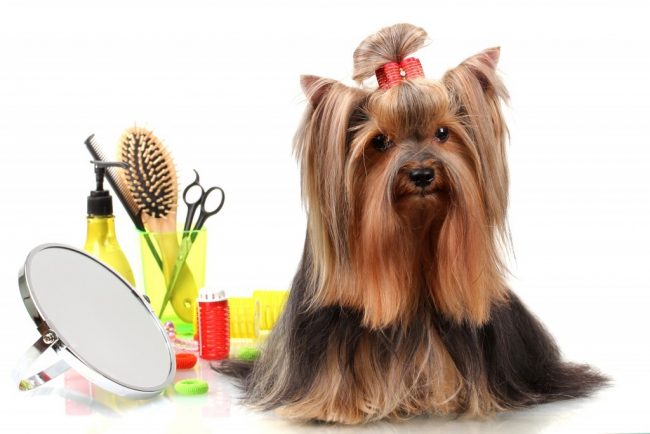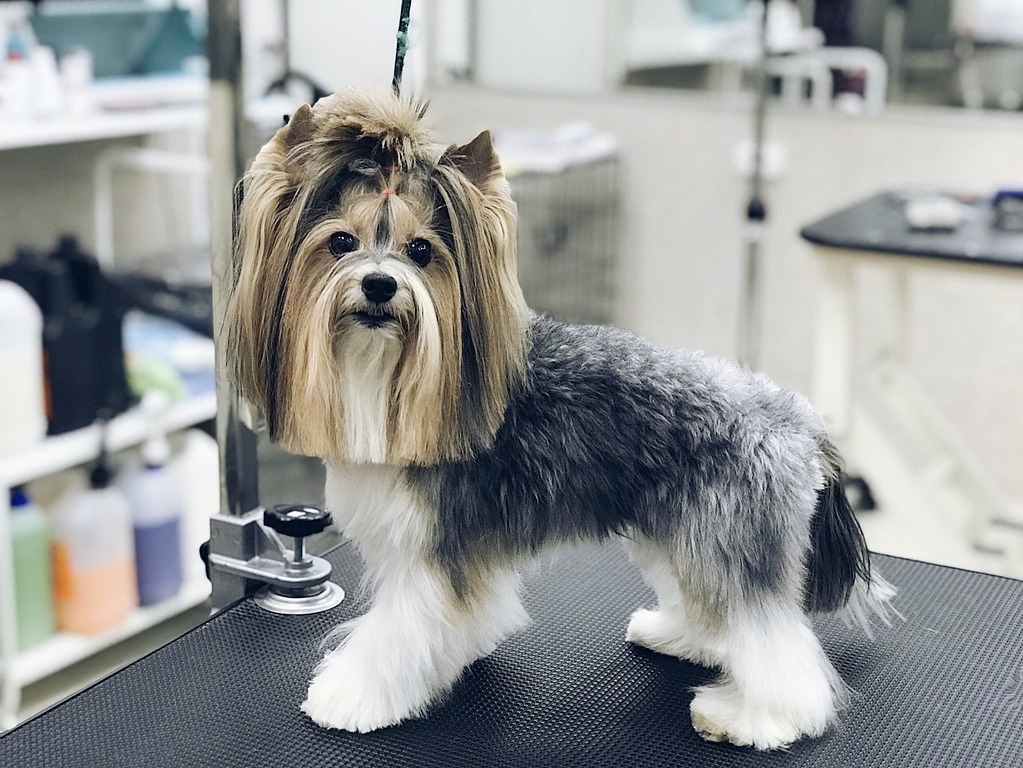Except for a few rare breeds of hairless dogs, all of our favorite four-legged friends have a more or less distinctive coat. And the fur of our dogs needs a lot of care. For some breeds, grooming is more or less time-consuming. You can find tips on grooming your dog in this article.
Why is grooming so important for dogs?

There are dogs with long, short, smooth, and curly fur and four-legged friends that have no or a very dense undercoat. Just as people comb their hair every day, dogs should also be groomed regularly. Some breeds will do just fine with an occasional brushing, while other dogs will need daily combing and regular trimming or trimming of their hair. When it comes to moulting, grooming also differs from breed to breed. There are specific tools for each type of fur. Depending on the breed, brushes, combs, trimmers and much more are part of the basic equipment.
How do I care for my dog’s coat?
Combing and brushing are the most important activities in grooming. Loose hair must be removed. In addition, brushing should prevent knots from forming and the fur from becoming matted. With short-haired dogs, even light soiling can be easily brushed out of the fur. Once the dirt is dry, it works really well. It is not always necessary to bathe your four-legged friend.
The different coat types in dogs
The coat care and above all the effort for it depends on the type of coat of the dog. In dogs we distinguish between:
- short-haired dogs,
- long-haired dogs,
- dogs with curly fur,
- wirehaired dogs,
- dogs with little or no fur
- and felt-haired dogs.
Short-haired dogs
Examples of short-haired dogs are boxers, pinschers, pit bulls, short-haired chihuahuas, mastiffs, dalmatians, mountain dogs and many more. These dog breeds also usually have little or no undercoat. Grooming these dogs is absolutely uncomplicated. It is enough if the four-legged friends are brushed from time to time. The change of coat is also not particularly noticeable in these breeds. Dogs shed more or less hair throughout the year.
Long Haired Dogs
Long-coated dog breeds include long-haired Chihuahuas, Shi Tsus, Spitz, Golden Retrievers, Yorkshire Terriers, Havanese, Irish Setters, Bobtails, Tibetan Terriers, and numerous others. In the case of long-haired dogs, a distinction must also be made as to whether they have a strong or little undercoat. The more undercoat the animal has, the more complex grooming becomes.
There are also dogs whose fur is constantly growing. Here the dog’s coat not only has to be brushed and combed, but also trimmed and trimmed regularly. Anyone who cannot or does not want to cut and trim the fur of their Poodle, West Highland White Terrier, Yorkshire Terrier or Fox Terrier themselves should plan regular visits to the dog groomer.
How often do I have to brush my dog?
How often you have to brush your dog also depends on its coat type. Long-haired dogs with a thick or fine undercoat should be brushed briefly every day. Two to three times a week is enough for short-haired dogs.
Dogs with curly fur
All water dogs are curly-coated dogs. The curls are also absolutely typical for poodles. Curley Coated Retrievers are goldies with curly fur, and the Bichon Frize, Airedale Terrier, Bolognese, Barbet and Kerry Blue Terrier also enchant with their adorable curls. The soft, fluffy undercoat is also typical of the breed for these dogs. In addition, these animals are hardly subject to a change of coat. Most of these breeds require regular clipping. The dog’s fur must also be trimmed regularly on the pads, eyes and ears.
Wirehaired dogs
Many hunting dogs have a wiry coat. This is almost predestined for hunting because it is robust and water-repellent. The wire-haired fur does not feel cuddly, but rather hard. The German Wirehaired Pointer even has the coat in its name, as does the Wirehaired Dachshund. The Border Terrier, Schnauzer, and Vizsla also have wiry coats. Many wirehaired breeds also have a lush undercoat. This must be consistently brushed and combed out. Regular trimming is often necessary for dogs with wiry top coats.
Hairless dogs
Hairless dogs usually have some fur on their heads, paws and legs. This does not have to be particularly cared for, just combed with a soft brush. Therefore, more care should be taken on the skin of these animals. In the summer, hairless dogs need a t-shirt or sun block to keep them from getting sunburned. In winter, dogs without fur have to wear a sweater more often because they freeze faster. Dogs without fur may also suffer from dry skin more often. In this case, the skin must be creamed regularly.
Felt-haired dogs

These dogs are referred to as having a so-called special coat. The Puli is one of the best-known representatives of these breeds. The fur is actually just undercoat. This is also curled and turns quickly in itself. The hair is very soft and silky, so it quickly becomes matted. As soon as the fur has grown just a few centimetres, real dreads form. Skin care is extremely important here. If these dogs are not groomed consistently, eczema and inflammation can develop underneath these matted dreads.
What can I give my dog for a shiny coat?
Omega 3 fatty acids are the magic bullet for a shiny coat. These fatty acids are mainly found in salmon, herring and tuna. Linseed oil and linseed are also rich in omega 3 fatty acids. Although you might think that regular bathing will help keep their coat shiny, the opposite is true. Bathing too often destroys the natural layer of fat on your four-legged friend’s skin. This tends to dull the coat rather than make it shiny.
The consequences of poor grooming in dogs
Anyone who has ever seen a feral street dog on vacation knows what can happen if a lack of grooming can happen. Not only parasites of all kinds feel absolutely comfortable in this fur and transmit diseases of all kinds. The skin is also damaged by the matted, dirty fur. These dogs get eczema, rashes and skin diseases easily. The skin becomes crusted and scabbed and it can also lead to suppurating sores.
Our dogs rarely get that bad. However, insufficient grooming of pets can also cause severe itching, skin problems and even open wounds. The dog also feels significantly more comfortable with the right coat care. In addition, the dog immediately looks much nicer. Everyone wants a pretty dog with a silky shiny coat.
Therefore, the few minutes a day for grooming should not be spared. Most fur noses also enjoy grooming as an additional pat. In order for fur care to work well, it is important to get the animals used to brushes, combs and scissors when they are puppies. Puppies should also be accustomed to the trimmer and the buzzing of the razor from an early age. So there are no difficulties later when using it and the four-legged friend stays wonderfully still when trimming.
What care products and aids are there for grooming dogs?
As strange as it may sound, grooming starts with nutrition. A high-protein diet is important for a shiny, healthy coat. Dog food should also contain a lot of amino acids. Unsaturated fatty acids in the form of high-quality vegetable oils are also important for a healthy coat. Zinc, vitamin C, copper and linoleic acid are also important nutrients to include in a good dog food. Special wet or dry food for a healthy and shiny coat is available in every well-stocked specialist shop or online. If you barf your dog, you should make sure that your dog gets these nutrients with his meals. If the dog’s coat is always dull and doesn’t want to shine at all, this can be an indication of a defect. Dandruff, rashes and dry patches usually indicate malnutrition or other health problems. If you notice this with daily grooming, you should talk to a vet about it or adjust the diet.
In general, dogs do not need to be bathed and shampooed regularly. Short-haired dogs in particular only have to take a bath if they have rolled in smelly faeces or carrion while walking. However, some dogs make it every day that they come home full of mud and smelly from the forest and meadow round. In this case, it will not help and the dog will have to be bathed. There are special shampoos that are designed for the skin and fur of four-legged friends. Normal human shampoo should not be used. In most cases, this is far too intense and too sharp. In a pinch, a very mild unscented baby shampoo can be used.
How does my dog’s fur get soft?

Often the problem of dull coat is actually diet. Dogs with a healthy intestinal mucosa usually also have a beautiful, soft and shiny coat. You can strengthen a healthy intestinal flora in dogs with probiotics. Ask your vet how to rebuild your dog’s intestinal flora. There are special pastes and agents for this. However, it often helps to include kefir, kombucha, apple cider vinegar and herbs such as oregano and thyme in the dog’s diet.
If the dog has caught lice or fleas, there are special shampoos on the market that get rid of them. Here, however, products with natural ingredients should be used. Lemongrass and mint flea shampoos are usually just as effective as chemical-heavy parasite shampoos. If the soft, silky coat becomes knotted very quickly, a conditioner can also be helpful. This can be applied like balm when bathing. They are also available as so-called leave-in conditioners. These are available as a cream, lotion or spray.
Recently it has also become very fashionable to use special perfumes for dogs. Dogs, however, do not need perfume. A healthy dog doesn’t stink even when it’s dry. It is normal for a wet dog to smell something special and every dog owner should put up with that. However, if it is absolutely necessary to use a perfume, then it should be a pH-neutral product. Perfumed vegetable oils, which are good for the skin, are also the most acceptable.
If your four-legged friend always stinks, despite care and good, balanced food, a health problem can be the cause. Check the teeth and ears first. Rotten teeth and mites in the ears are also common causes of unpleasant odor in dogs. If you cannot find a trigger, you should clarify this with your veterinarian. It could be a stomach problem.
Brushes, combs and the like – everything you need for grooming your dog
A wide variety of combs and brushes are available on the market. Be sure to pay attention to high quality here. If you are unsure whether the brush is comfortable, try it on yourself. If it hurts you to comb it, then it won’t be comfortable for the dog either. Also choose brushes and combs based on the length of the coat. The longer the fur, the longer the bristles and edges must be.
For dogs with short and easy-care fur, a brushing glove is often sufficient. This allows you to remove loose hair and massage your dog at the same time. Most dogs love this treatment with the special glove. In dogs with rough hair, the hair does not come off by itself. This needs help. It is best to use a so-called slicker brush for this. This reliably removes the dead hair from the coat. In some dogs with a very fine undercoat, matting occurs again and again, despite regular grooming. These can be carefully removed with a coarse and then with a fine comb. However, this often no longer helps and a detangling knife must be used. You can also use scissors for this.
If the dog has a very dense undercoat then the Furminator is a great product for removing it. With this, parts of the undercoat are shaved out in a special way. Even knots and small tangles can be removed with this gadget. However, the Furminator is only suitable for dogs with a dense undercoat.
If a dog needs regular clipping, consider buying a dog clipper. A model with an Aku is best suited so that you are not dependent on a cable. It is best to get the puppy used to the sound of the clippers beforehand. So he later has fewer problems with the hum. Don’t forget to give the dog a treat whenever the machine is turned on. This is how you work with positive reinforcement. The four-legged friend associates the razor with something positive and enjoys the treatment. If you don’t know exactly how to shear or cut your dog at the beginning, just get advice from a dog groomer. He will be happy to show you the most important steps and tell you exactly what to look out for.
It is best to use scissors to trim the fur around the eyes, ears and the tufts under the paws. It is important that you always have good control here. If hair grows in the eyes, this can irritate the eyes and long hair in the ears could also lead to inflammation and unpleasant tickling.
Which brush do I use for dogs with undercoats?

Dogs with long hair and a dense undercoat are best groomed with a coarse dog brush and roller comb. The Furminator can also be used for dense undercoats. For dogs with short fur and a dense undercoat, it is best to use a rubber curry comb.
Dog grooming – How to get your dog used to brush
The earlier the four-legged friend gets used to grooming, the better it is of course. When the puppy moves in with you, you can start gently brushing after just one day. For the dog, this should be as normal as eating, playing, or learning commands. Make sure that you always comb the dog in a relaxed environment.
When an adult dog moves in that has never or rarely been brushed and combed before, things can get a bit tricky. But with a lot of patience, rest and treats, that works too. Let the dog sit comfortably in front of you or lie down and start grooming.
But you can also brush the dog if you cuddle together on the couch. Make brushing a daily ritual. If your dog doesn’t want to be brushed at all, then don’t. Try again later. But don’t force your dog to groom it. He should not associate the brush with something unpleasant.
What role does diet play in grooming?

A balanced diet plays a huge role in grooming. High-quality vegetable or fish oils with omega 3, 6 and 9 fatty acids should be regularly incorporated into the diet. You can also drizzle this over the feed without hesitation. These fish oils are also available in capsules, for example, if your dog does not like them. Most dogs, however, are downright crazy about salmon oil. Hemp oil and linseed oil are also high-quality vegetable oils that contribute to a shiny and healthy coat.
You can also mix coconut oil into the feed, for example. You can also rub your dog’s fur directly with it. In many dogs, coconut oil also has a preventive effect against ticks and other parasites. When taken orally, many dog owners swear that coconut oil is a natural protection against worms.



























